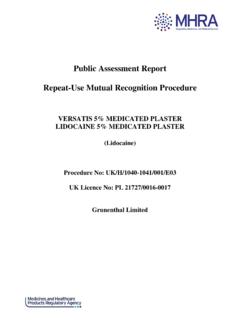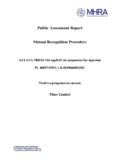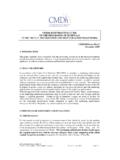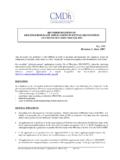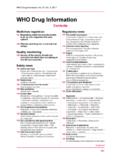Transcription of All About Regulatory Affairs - Granzer
1 All About Regulatory AffairsForum Heidelberg August 2010Dr. Ulrich of procedure When do we have a choice of procedure for a generic medicinal product? When the originator product was approved centrally New pharmaceutical forms with new features are no generics When it is a classical small molecule Independent of indication! When it fulfils the eligibility criteria for the centralized procedure Innovation Novel (new) technology3 MRP and DCPS cope4 Scope of MRP/DCP: New active substances (if not mandatory for the centralised procedure) Generic medicinal products to authorised reference medicinal products Informed consent Well established use (WEU; bibliographic applications) line extensions to national authorisations known substances in new combination New indications/new pharmaceutical forms for known substances5 Article 17 of Directive 2001/83/EC 1..Applications for marketing authorizations in two or more Member States in respect of the same medicinal product shall be submitted in accordance with Articles 27 to Where a Member State notes that another marketing authorization application for the same medicinal product is being examined in another Member State, the Member State concerned shall decline to assess the application and shall advise the applicant that Articles 27 to 39 apply.
2 6 Article 18 of Directive 2001/83/EC Where a Member State is informed in accordance with Article 8(3)(1) that another Member State has authorized a medicinal product which is the subject of a marketing authorization application in the Member State concerned, it shall reject the application unless it was submitted in compliance with Articles 27 to 39. Factors influencing the selection of procedure Marketing agreements Co-marketing: No of independent marketing authorizations No of Trade Names Co-promotion Only one Trade Name No of partners in the EU Markets, where the product shall be launchedMRP still a choice? Single (national) approval first Followed by MR round(s)9 Application to first member stateAssessment reportincluding SPC, PIL First Authorization: RMS210 daysApplicant request on mutual recognition of first(reference) authorisationMutual recognition ProcessObjections from CMSsBy day 50clarification and dialogue / point ofview of applicant (orally or writing)resolution of issuesAdditional National Authorization(s)35 daysNational evaluation and licencing processMutual recognition Procedure90 days5 daysMR advantages and issues No slots necessary Freedom to chose the national authority Timelines can be negotiated on a national level Option to be faster than in DCP due to immediate start But: one single country first, loss of marketing opportunity for multinational companiesDCP - Slots The ProblemNo of procedures finished in 2008 MRP: Split by Member StateDCP: Split by Member State15 EEA distribution of RMS rolesWhy bother with the Centralized Procedure?
3 Decentralised Procedure1718 Application to all member statesRMS to start reviewCMSs send comments to RMS and Applicant Consultation between RMS, CMS and Applicant (5 days)PAR to CMSs and Applicant70 daysDay 105: Clock stop orpositive close of procedureRMS updates PrAR to prepare draft AR (DAR)Day 106: Submission of the responseRMS evaluation of the dossier: Preliminary assessment report (PAR)Decentralized Procedure30 daysPreparation of response document by applicant3 6 monthsDay 120: Consensus?End of procedureDay 120: No consensus?Follow on process19 Day 120: Follow on processCMSs send comments to RMS and Applicant Consultation between RMS, CMS and Applicant (5 days)Day 145: CMSs send (final) comments on draft AR25 daysDay 150: Consensus?: Procedure is forwarded to the Coordination group for the mutual Recogntionand the Decentralized Procedure (CMD) Day 180: CMD becomes involvedCMSs prepare response to Draft assessment ReportDecentralized Procedure30 daysRMS prepares report on outstanding issues by Day 18030 daysDay 195: Discussion at CMD/Break out session End of procedureYes?
4 NO?Day 195: Discussion at CMD/Break out session Day 210: mutual Approval?Referral to CMDD ecentralized ProcedureEnd of procedureGrant of national licenses within 30 daysYes?NO?Publication ofAssessment report on the internetDay 195: Discussion at CMD/Break out session Day 210: mutual Approval?Referral to CMDD ecentralized ProcedureEnd of procedureGrant of national licenses within 30 daysYes?NO?: life becomes difficult!Publication ofAssessment report on the internet22 CMD(h)-Referral in DCP and MRPCMD-Referral - Trigger: Disagreementbetween MS concerned by the application at the end of MRP (Day 90) or DCP (Day 210) based on potential serious risk to public health What does this mean? If all are positive: Case closed If all are negative but the applicant: CASE CLOSEDOne MS, the RMS, has to be positive to trigger a referral24 Day 0 RMS starts procedure: Draft LoQ to MSs for commentsDay 10final LoQ to the ApplicantDay~201st CMD-Meeting: Discussion of caseDay 25 Response from Applicant on LoQ 10 days for preparation of response (day 11 day 20) No new information Usually no new arguments Improvement of statements if possible Cooperation with RMS, if RMS is positive Cooperation with CMS, if at least one CMS is positive60 Days CMD-Procedure (CMD-SOP)Day 35 Updated AR of the RMS to CMDDay 45 MSs position on response to LoQDay~50 Discussions at 2nd CMD-Meeting; Hearing of written commentsDay 60close of procedure with two options: consensus or referral to CHMP26 Withdrawal of Applications The applicant has the right to withdraw the application until the last day of the MRP or DCP.
5 However, if the applicant has withdrawn the application from a MS because a potential serious risk to public health was raised by this MS, the application will be automatically forewarded for discussion to the CMD(h) A withdrawal will not help the applicant!27 Referrals to CHMP in 2007 (21 Procedures)ProductReason for Referral to CHMPCHMPV antasSafety & EfficacypositiveFentastad (5)Bioequivalence, SPC, Quality, Non-clinicalNegative-RESimvastatin KrkaBioequivalencenegativeEformaxQuality , Safety & EfficacynegativeBicaluplex 150 mgSafety & Efficacy of an indicationpositiveXeominSafety & EfficacypositiveMenitorixSafety & EfficacypositiveCoxtralEfficacynegativeP ulairmaxQuality, Safety & EfficacynegativeOraceaSafety & EfficacypositiveRapinylSafety & EfficacypositiveAlvescoEfficacypositiveA torvastatin (4)BioequivalencewithdrawnSlots current situation UK: depends on indication, no clear guidance, ask S: slot days where requests for certain times are being accepted D: Slots in 2012 and 2013 NL: Working on system, but no quick slots DK: Already in 2012 Makes CP attractive?
6 ???The centralized procedureEligibility For all New Molecular Entities For all Biotech-Products For all Advanced Therapies For innovative products For all products, which originally were authorized using the centralized procedureGenerics For all products, where the originator has used the CP generics have the choice to go either route: National and then MR DCP Central Biosimilars Must go centrally, although programs right now are being adapted towards a generic approach, G-CSF, where a pD testing is being acceptedThe CP: Pro s and Con sPro s One authorization for the entire EEA Approval costsCon s Loss in flexibility Co-Marketing Name (one name only) Parallel importation Increased complexity in contracts Rapporteur nominated by CHMP Intention to file 7 months prior to MAAThe Centralized Procedure Example: The European Medicines Agency (EMA) today adopted a positive opinion recommending for the first time the granting of a marketing authorisation for a generic of a centrally authorised medicine for human use.
7 The recommendation was made by the Agency s Committee for Medicinal Products for Human Use (CHMP) at its 16-19 July 2007 meeting. This first positive opinion is for Zalasta (olanzapine), from Krka, , Novo Mesto, which is intended for the treatment of schizophrenia and moderate to severe manic episode. The reference product for Zalasta is ZYPREXA from Eli Lilly Nederland BV, which has been authorised in the European Union since of Rapporteurs: Rapporteurships shall be open to all CHMP delegations. The scope of these Rapporteurships shall relate to the pre-authorisation phase and the introduction of quality changes in the post-authorisation maintenance. In the case that several different generic companies apply for applications based on the same bioequivalence study, the same Rapporteur shall be appointed to ensure consistency in the scientific evaluation/post authorisation maintenance of the medicinal products concerned. Optimally, these cases shall be identified at EMA pre-submission meetings with generic Centralised ProcedureArticles 6 14 of Regulation 726/2004 List of Questions CHMP MeetingCHMP OpinionDay 210 CHMP Meeting(Hearing)Additonal questions/issues:Dossier SubmissionNominationof Rapporteur and Co-Rapporteur byCHMPP reparation of assessment ReportCHMP Opinion Negative Positive 120 + DaysAppealFinal OpinionCommissionCommissionBindingCommis sion Decision(Approval)Draft DecisionMarketingAuthorisationHolderMemb er StatesStandingCommitteeApplication to EMAA pplicant.
8 Requestfor re-examination210 daysDeatiled groundsAbbreviation:MS = Member StateFinal CHMP OpinionFinal steps in CP & Commissions Decision Procedure45 days60 daysImportant new questions of ascientific or technical natureApplicant: No requestfor re-examinationCHMP OpinionDraft of Commission Decision15 daysTransmission of the opinion with Annexesto Commission, MS and applicant15 daysStanding CommitteeApplicant15 daysReferral to Agency new RapporteurYESF inal Commission Decision = ApprovalNOCommunication to the Council: Commission may defer the decision for 1 monthCouncil may take adivergent decision22 days15 days15 daysSummary The CP is an alternative to the DCP/MR if: The product should be marketed in the majority of the EEA countries If one trade name is being used If co-promotion is the only option for partnership If co-marketing: more than one license, approval of additional licenses by EU commission If one central pharmacovigilance repository is being keptScientific Advice: Beispiel USAS tructure and content of key FDA Meetings and its EU counterpartsMeeting with the FDA Nothing required Highly recommended Three different types: A; B; CTimelines for the different meetingsType A Immediate need - stalled drug development program ( , a critical path) Generally reserved for dispute resolution, to discuss clinical holds, and special protocol assessment Scheduled with 30 days of FDA receipt of a written request Company may not want to have such a meeting!
9 !!!!!!!!!!!!!!Type B Pre-IND Certain end of Phase 1 End of Phase 2/pre-Phase 3 Pre-NDA/BLA FDA generally grants one each of the Type B for each potential application ( , NDA, BLA). Scheduled within 60 days of the FDA receipt of the written requestType C Do not pertain to the development/review of NDA Policy meeting, meetign on a special item of global importance, like discussion on surrogate endpoints Not related to advertising/promotional labeling launch activities and materials Scheduled within 75 days of requestPre-IND meeting Primary focus on pre-clinical and clinical data to support proposed initial IND trial Preliminary overview of proposed drug development program May be equivalent to EOP1 or EOP2 meeting for drugs already studied in foreign countries or under other INDs Goal: Avoid clinical hold on initial INDEnd of phase II meeting Most important meeting between FDA and sponsor during drug development Review of pre-clinical, clinical, and CMC data from Phase 1 and 2 studies Review proposed pivotal trials and overall drug development program Focus on proposed claims for labeling Goal.
10 FDA agreement to Phase 3 programPre-NDA (pre-Submission) meeting Ideally 6 to 12 months before planned NDA submission Uncover major, unresolved problems Preliminary review of data from Phase 3 studies Primary focus on format and content of NDA Discussion of plan for electronic submission Goals: Avoid refusal to file and prepare for efficient review of NDAS pecial Protocol assessment Reauthorization of PDUFA 1997 (PDUFA II) -Provision for special protocol assessment & agreement Evaluate within 45 days certain protocols / issues to assess adequacy per scientific / Regulatory requirementsProcedure Sponsor sends written request Purpose: Reach agreement on design/trial size Binding for sponsor and FDA after trial start Exemptions: With written agreement of sponsor & FDA If Director/FDA Reviewing division determines asubstantial scientific issue essential for determination of safety or effectiveness of trial was identified after testing began. Timing: Usually response within 45 d after submissionCDER ADVISORY COMMITTEES Anesthetic and Life Support Drugs Anti-Infective Drugs Antiviral Drugs Arthritis Drugs Cardiovascular and Renal Drugs Dermatologic and Ophthalmic Drugs Drug Safety and Risk Management Endocrinologic and Metabolic Drugs Gastrointestinal Drugs Nonprescription Drugs Oncologic Drugs Peripheral & Central Nervous System Drugs Pharmaceutical Science Psychopharmacologic DrugsUse First product in a particular class Major new uses Products that have significant public attention/controversy Major guidelines Significant safety/efficacy issues FDA seeks input by panel of outside expertsdue to sponsor disagreement with FDA decision Matters involving divergent scientific opinions Rx => OTC switches Further info: Meetings with the FDA Who is responsible.
